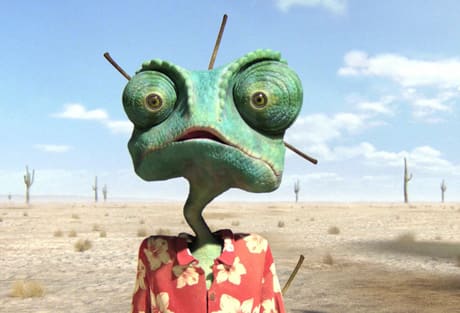By eschewing traditional animation tactics in favour of his live action cinematic strengths, Gore Verbinski has broken new ground in the medium. Sure, the story of Rango is nothing new — a nameless drifter trying to find himself stumbles into the undeserved role of hero — but it's not meant to be. What Verbinski and his team of writers and animators have created is an existential homage to cinema — Westerns, in particular. A common chameleon who fancies himself an actor finds himself caught up in the troubles of a small, lawless town in the desert after his safe glass home shatters on the highway and he has to choose which side of the road to walk. There's no lack of metaphors at play here. This fourth-wall breaking meta-commentary on the nature of self and how we dress in personas to cover a lack of personal understanding is a big part of what makes Rango work well for older audiences. The goofy comedic timing, snappy dialogue and cartoonish depiction of very adult situations will make this endearingly imperfect, and sometimes downright despicable, little lizard a favourite for kids tired of being pandered to. Outside of a Pixar production, I've never seen a film with such cross-generational appeal. But Rango trumps even the titans of mature animated fare when it comes to cinematic stylization. A big part of that is the elaborate process, shown in the extensive and enthralling "Breaking the Rules" feature. You can see the zest for and care invested in the project, from conception to completion, as Verbinski and his collaborators hammer out story structure and logic, designers sketch and refine the various anthropomorphised desert critters populating the town of Dirt, the ILM animation team pore over every detail at Verbinski's behest, and cinematographer extraordinaire Roger Deakins consults on lighting choices. Seeing the cast together on a sound stage, in partial costume, essentially putting on a stage play of the film instead of recording their voices separately in little booths, is delightful, explaining why this feels more like an ensemble acting piece than a regular animated feature. Johnny Depp gives one of his best performances in years, describing the process as "emotion capture," with the animators using the full performances of the talented cast as reference, rather than the usual array of basic expressions. A collection of deleted scenes are best experienced in the extended cut, which also comes with feature commentary from Verbinski, a couple co-writers and members of the production team. The theatrical version is sided with a full storyboard reel picture-in-picture. "Real Creatures of Dirt" takes a look at many of the real-life inspirations for the animals and insects with crazy wildlife expert Donald Schultz, while cast and crewmembers interject their thoughts on how the creatures were adapted for characterization. Why any sane person would provoke a rattlesnake as much as Schultz does is beyond me, but it's an informative piece, however much the host deserves to get bitten. "A Field Trip to Dirt" is an interactive model of the town you can navigate through to get extra titbits of information on the characters and see examples of their design evolution, from sketches to fully rendered models. Rango is about as good as special features, and animated family films, get.
(Paramount Pictures)Rango [Blu-Ray]
Gore Verbinski

BY Scott A. GrayPublished Jul 13, 2011